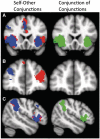Familiarity promotes the blurring of self and other in the neural representation of threat
- PMID: 22563005
- PMCID: PMC3739912
- DOI: 10.1093/scan/nss046
Familiarity promotes the blurring of self and other in the neural representation of threat
Abstract
Neurobiological investigations of empathy often support an embodied simulation account. Using functional magnetic resonance imaging (fMRI), we monitored statistical associations between brain activations indicating self-focused threat to those indicating threats to a familiar friend or an unfamiliar stranger. Results in regions such as the anterior insula, putamen and supramarginal gyrus indicate that self-focused threat activations are robustly correlated with friend-focused threat activations but not stranger-focused threat activations. These results suggest that one of the defining features of human social bonding may be increasing levels of overlap between neural representations of self and other. This article presents a novel and important methodological approach to fMRI empathy studies, which informs how differences in brain activation can be detected in such studies and how covariate approaches can provide novel and important information regarding the brain and empathy.
Keywords: emotion; empathy; familiarity; interpersonal relationships; prosocial behavior; social cognition.
Figures




References
-
- Andersen AM, Chen S. The relational self: an interpersonal social-cognitive theory. Psychological Review. 2002;109:619–45. - PubMed
-
- Aron EN, Aron A. Love and expansion of the self: the state of the model. Personal Relationships. 1996;3:45–58.
-
- Aron A, Aron EN, Smollan D. Inclusion of other in the self scale and the structure of interpersonal closeness. Journal of Personality and Social Psychology. 1992;63:596–612.
-
- Aron A, Fraley B. Relationship closeness as including other in the self: cognitive underpinnings and measures. Social Cognition. 1999;17:140–60.

